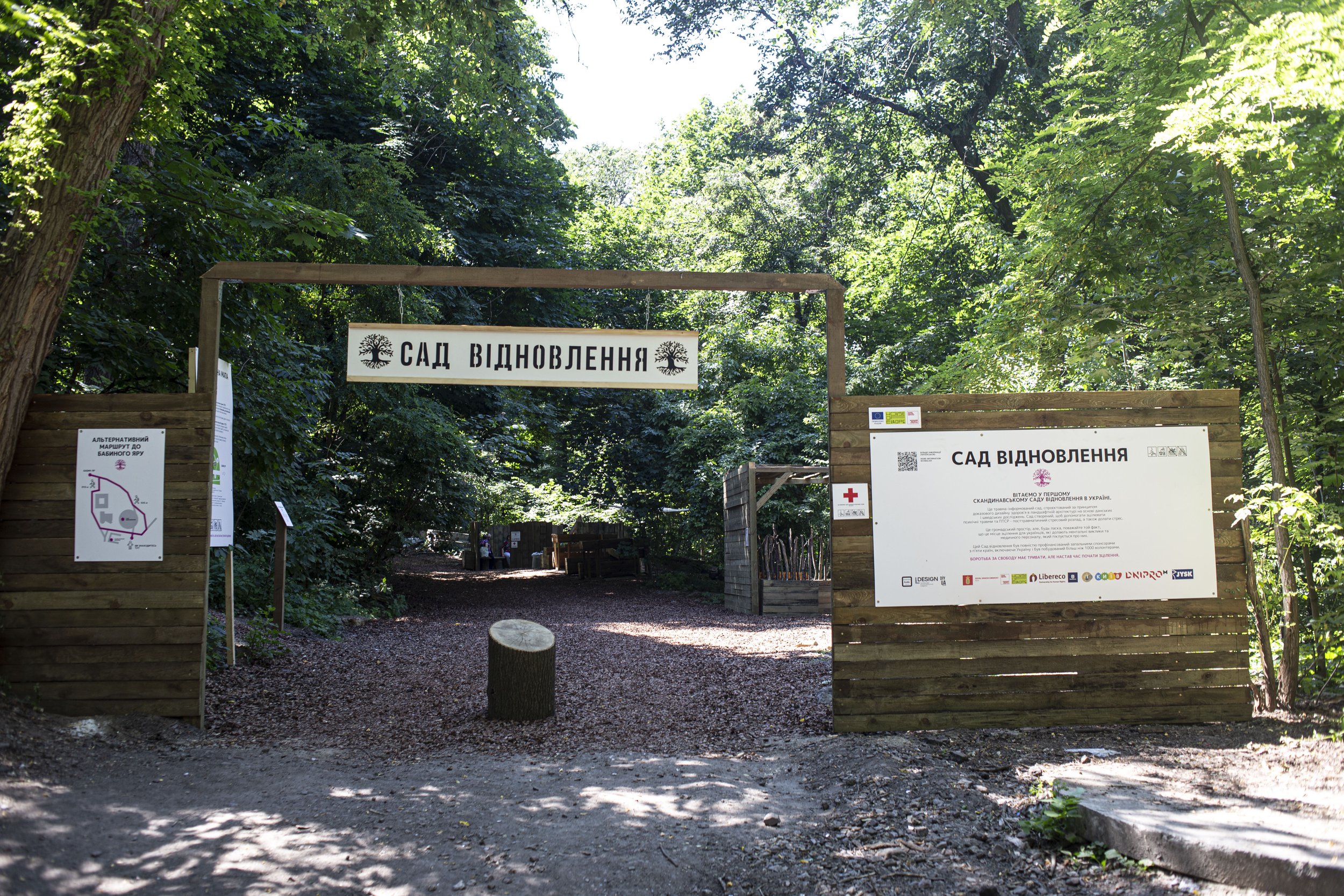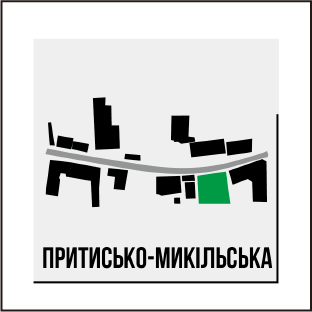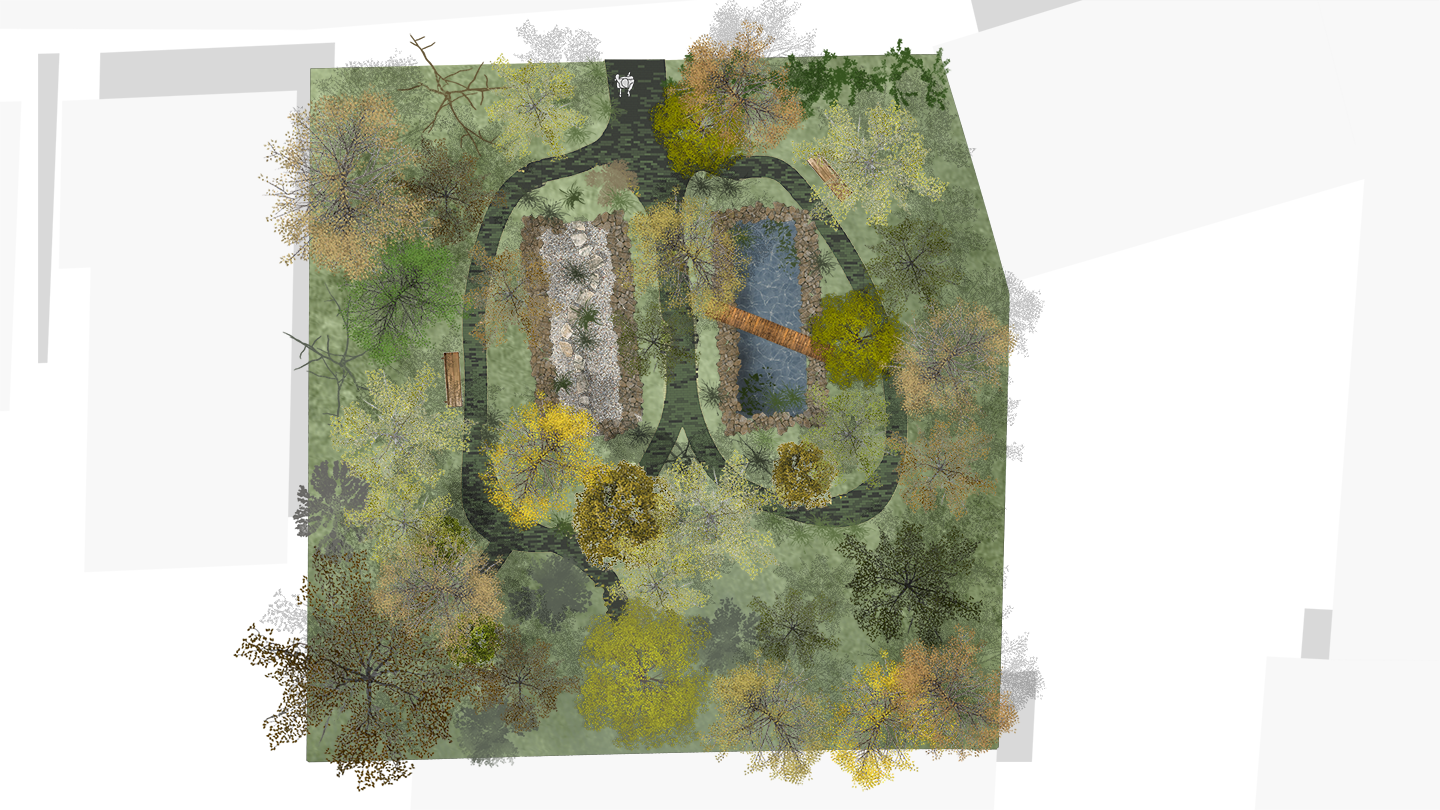
Healing spaces for citizens with mental trauma and PTSD
Nordic Therapy Gardens for Ukraine
Nordic Therapy Gardens
-

Ukraine's Mental Health Crisis
Ukraine faces countless challenges because of the full invasion. One of them is the growing health crisis due to mental trauma and/or PTSD and because of the lack of preparedness in the country to tackle, it risks becoming a veritable epidemic.
An untold number of civilians facing bombardments in their cities and towns and veterans returning from the war are suffering from various degrees of mental trauma. Domestic abuse cases are rising rapidly, too, which highlights the fact that mental trauma can affect others than the patient themself.
Therapy gardens are not a singular solution but they are a massive step in the right direction. Not least because like in many cultures, talking about mental health is still a taboo. Legitimizing the conversation by designing and building therapy gardens in Ukraine is also a positive aspect to the projects because it will create important dialogue as well as providing concrete, nature-based healing.
The body of science about the benefits of therapy gardens is advancing rapidly. In our research, however, we have seen a lack of specific focus on the needs of veterans who have been witness to brutal warfare. We have been conducting comprehensive research about how to design specifically for their needs and will implement our findings in the therapy garden.
-

Trauma-informed Nature-based Healing by Coolville Design Lab
A Trauma-informed Therapy Garden is much more than a “therapeutic garden”. By using Evidence-based Health Design In Landscape Architecture (EBHDL) we will meticulously design to incorporate elements promoting relaxation, mindfulness, and sensory stimulation that can not only relieve stress but also heal mental trauma. It involves using calming colors, soft textures, and fragrant plants, as well as secluded areas for solitude and reflection and communal spaces for social interaction and support. The design prioritizes fostering a sense of control, empowerment, and emotional resilience for those seeking solace and restoration from traumatic experiences.
We will employ sustainable design & architecture, biodiverse landscaping that respects native species.
The Science
The healing properties of gardens in general has been documented since Roman times. Now, our scientific understanding of the mental health benefits derived from green spaces has been advancing significantly over the past few decades. Therapy - or sensory - gardens are now widely accepted as a form of medicine. Through multi-disciplinary approaches, we aim to enhance the design of trauma-informed gardens, with a specific focus on addressing the needs of veterans suffering from PTSD.
-

Pilot Project in Kyiv (2024)
We have selected a plot of land in the historic Podil district of Kyiv as the location of a pilot project that will create awareness and act as a proof-of-concept. It is located right next to Pavlov Psychiatric Hospital, with 1000 patients. This garden will provide solace and healing for any citizen who needs it, as well as start the dialogue about the concept of therapy gardens in the Ukrainian context.
The land is lightly forested and is registered as a nature reserve and with low-impact interventions - both physical and visual - we will create a garden that will in effect become a new hospital ward for healing patients.
Coolville Design Lab’s Podil pilot project has a growing number of partners and associates.
NGO Kosmos Tabir | The City of Copenhagen (Kyiv Office) | Libereco.org | Danish Cultural Institute | Danish Embassy Kyiv |
If you’re interested in being a partner or a sponsor, please use the contact page to send an email.
-

Beyond the Pilot Project
In addition to building the first therapy garden in Ukraine, our intervention will also have other benefits:
- We will, together with Pavlov Hospital, develop a learning hub where health professionals from around the country can come to learn about what these gardens can do and how to use them. In addition, landscape architects can come and learn how to design them. We will provide open source knowledge in order to spread the design to as many people as possible.
More Gardens in Other Ukrainian Cities & Towns
The most encouraging thing about the concept of Therapy Gardens in the Ukrainian context is how positive people are when we talk about them. Ukrainians are well aware of the mental health crisis and when pitching the idea of therapy gardens, we are happy that the concept is so intuitive to people.
We currently have early-stage plans for a therapy garden in Chernihiv and are exploring possibilities in other cities like Lviv and Mykolaiv. There is potential for therapy gardens in every Ukrainian city and town.







Design Thinking
-

Flora as Separators
A main design consideration revolves around carefully selected flora, including trees, bushes, and hedges. Only native species are chosen, promoting maximal biodiversity coexistence.
Sensory-rich areas are strategically designed with fragrant plants, some of which retain leaves in winter. Vegetation is selected for its efficacy in absorbing sounds, buffering users from wind, and providing therapeutic benefits.
In addition to the greenery, various techniques and design choices are employed for physical separation behind benches. Low walls constructed from piled logs, hay bales, and natural screens with climbing plants offer not only aesthetic appeal but also contribute to a sense of protection and enclosure within the distinct zones of the garden.
-

Sustainable Nordic Design
The Best Practice design of an effective trauma-informed space is highly detailed, with a long list of elements to be considered. A combination of landscape architecture and urban design will strengthen the design concept.
In this modern age it is relevant and important to focus on sustainable materials in our design but such materials are a natural inclusion in a trauma-informed park focused on healing and sensory experiences. Benches and chairs will be simple but comfortable constructions using recycled materials wherever possible - like wooden planks.
The navigation will be designed with clear signage and intuitive pathways featuring one-way directions, easy-to-read symbols and graphics and different symbols for the different zones. There will be rainwater collection barrels in place.
-

Designing for Different Needs
Users of the space encompass a diverse spectrum of personal struggles, with some preferring solitude (closed users) and others seeking human interaction (open users) as part of their healing process. The design will account for these varied needs, addressing the three primary stages of users within the spectrum of personal experiences.
1. Internal Healing: Some of the users will have a hard time just going outside and will not wish to interact with others. Designing for them is designing solitary spaces with long views and highly detailed elements that ensure a safe experience.
2. Reconnection: These users need a high sensory environment with, for example, aromatic flowers and water elements.
3. Physicality: These users will feel a need to insert their physical labour into the space. This can include weeding, gardening, watering the plants, sweeping - and just generally caring for the space.
The Science
-
Evidence-based Research
The meticulous design and ongoing maintenance of a trauma-informed garden prioritizes the cultivation of a sense of control, empowerment, and emotional resilience, creating a haven for those seeking solace and restoration from traumatic experiences.
Recognizing the diverse spectrum of trauma experienced by users, the garden’s design takes into account varying levels of struggle, offering tailored zones to meet different needs. From individuals facing profound challenges to those requiring a gentler approach to healing, these designated spaces cater to a range of experiences.
Our evolving scientific understanding underscores the therapeutic value of green spaces for mental health, and the consensus is clear: gardens act as a healing balm. Armed with this knowledge, we are poised to elevate the design of trauma-informed gardens and parks, incorporating a diverse array of multidisciplinary approaches. The design principles of Therapy Gardens emphasize sustainability in both architecture and landscaping, employing native species to create sensory-rich environments.
-
Salutogenic Theory
In salutogenic theory, people continually battle with the effects of trauma and/or hardship. These forces are called generalized resource deficits (GRDs). On the other hand, there are generalized resistance resources (GRRs), which are all of the resources that help a person cope and are effective in avoiding or combating a range of psychosocial stressors.
Attention Restoration Theory
Humans are constantly processing information in their surroundings. In non-natural urban environments, we employ ‘Goal-oriented Attention,’ dealing with an influx of information that demands cognitive processing.
This system is limited and energy-consuming, potentially leading to mental exhaustion and stress. The need for targeted attention can overload the brain, triggering the nervous system and causing sleeping disorders.
Natural and garden environments don’t require sorting and prioritizing impressions. Instead, humans engage in ‘Spontaneous Attention,’ an unlimited, energy-free system triggered by spontaneous fascination.
-
Psycho-Evolutionary Theory
This ‘stress reduction theory’ suggests that humans are naturally inclined to flourish in natural environments - and have been since the Stone Age.
Despite modern urban lifestyles, our genetic makeup aligns with ancestors who relied on nature, leading to instinctual reactions.
Prospect Refuge Theory
There is an intricate relationship between humans and their natural surroundings, drawing from our ancestral hunter-gatherer instincts.
We regard our environment based on the need for refuges, such as caves for hiding or hilltops for scouting. Which means designing to eliminate interruptions that cause mental fatigue.







